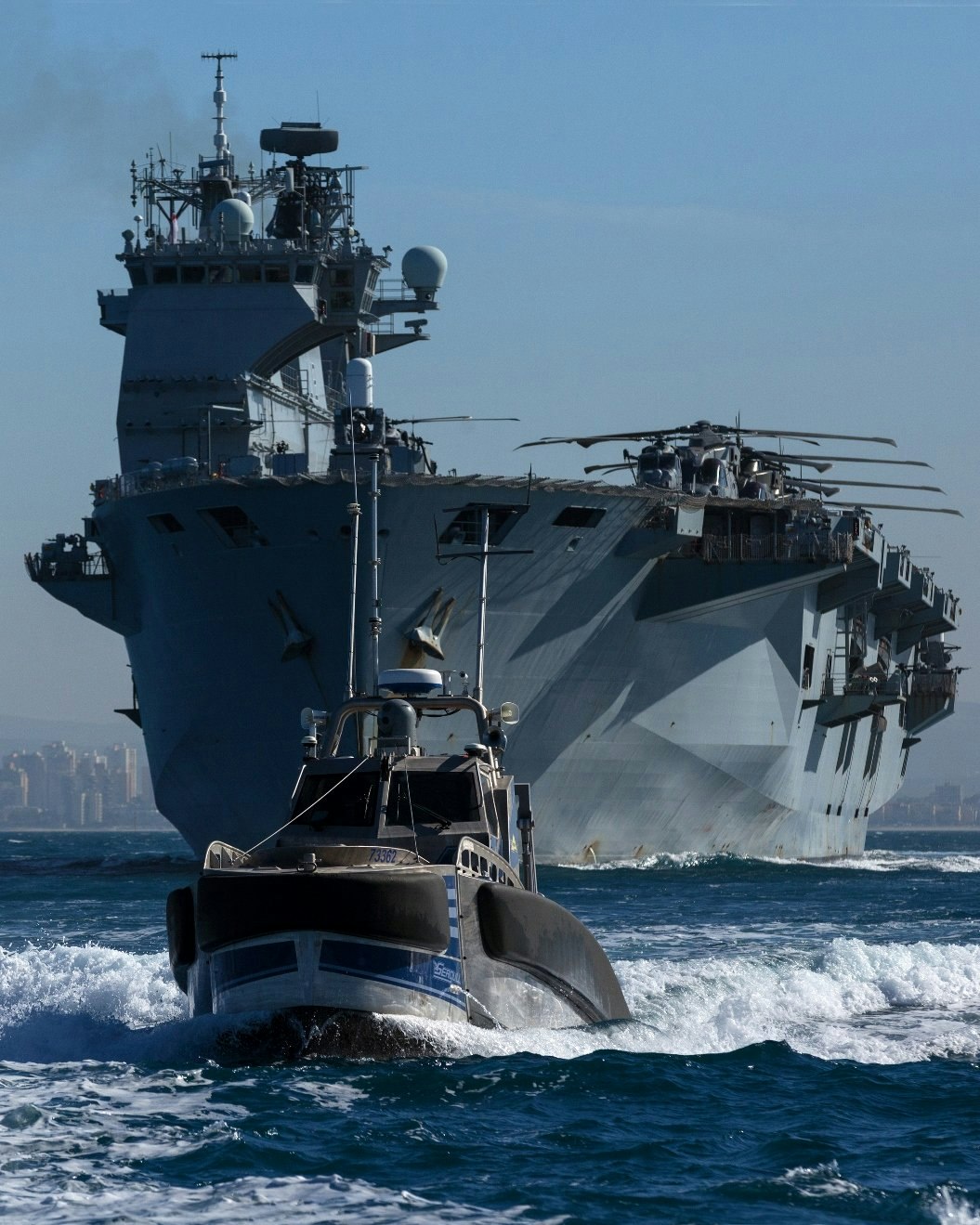Elbit Systems announced that its Seagull Unmanned Surface Vessel (USV) was deployed by NATO forces in a recent joint Anti-Submarine Warfare (ASW) exercise.
The ASW force included the Spanish Navy’s Santa Maria class frigate Victoria, Royal Navy’s Type 45 HMS Duncan as well as the Seagull USV.
In a release the company said:
“Having a far greater endurance than ASW helicopters often used in similar missions, the Seagull USV performed anti-submarine area sanitization as well as the ASW forward picket force, providing longer time on station, yielding persistent detection and contact maintenance capabilities.”
In addition to its ASW capabilities, the Seagull features a plug and play, modular mission payload suite and can perform Mine Counter Measures (MCM) missions, Electronic Warfare (EW), Maritime Security (MS), Hydrography and other missions using the same vessel, a mission control system and data links.
Last year, an Elbit Systems Seagull unmanned vessel and helicopter carrier HMS Ocean participated in an exercise between the Royal Navy and the Israeli Navy.
During the exercise the USV performed a Mine Counter Measure (MCM) mission, scanning and charting a secure path for HMS Ocean. Once encountering Mine-Like-Objects, the Seagull alerted HMS Ocean to avoid them, thus securing its ‘safe route’ say Elbit.
The Seagull performed the mission while being remotely operated from a Mission Control Station onshore. Additionally, the Seagull took part in a tactical manoeuvring exercise and sailed in formation with Israeli Navy vessels HMS Ocean.















Didnt work though as it never saved Ocean Lol
Why is a 45 in an ASW exercise ?
To Establish a route toward’s unexpected flexibility perhaps
I’m certainly no expert but the way I read it is that this ASW exercise was a defensive operation as opposed to overtly offensive. Since T45 wasn’t designed for ASW I presume it would have to use Merlin to proactively search for threats and act as a picket rather than trail passive sonar or keep actively pinging for threats. Using USV is an option that provides persistence and probably at lower costs than a helicopter/dipping sonar approach.
But I’m just guessing so take it for what its worth 🙂
Because it has a sonar, a helo and torpedoes…
Same goes for why do T23 do anti aircraft drills…because they have radars guns and missiles.
LOL fair enough.
I had no idea a T45 has sonar actually.
Looking forward to seeing our Hercs flying combat sorties at Red Flag vs Red Air.
After all….they have wings!
Cheers anyway!
Funny response !
Well its more a matter of degrees. A T26 is designed to be extremely quiet for passive sonar detection and to help reduce its own detection by a submarine. The minimized noise not only helps to actually detect a submarine, which may be tough enough in itself with today’s very quiet AIP and state of the art nuclear subs, but ideally to identify what type and potentially exactly which boat it is, based on unique sound signatures.
T45 was designed primarily as AAW and not for ultra quiet operation. It has a bow sonar for sub, mine and torpedo detection but since it was not designed to be ultra quiet, its detection and identification capabilities will be less than the T26 and probably less than the ASW T23 too because of T45’s self generated noise. It can overcome that by using Merlin with dipping sonar operating independently of the ship or in conjunction with either passive or active sonar from the ship. But you can’t keep a Merlin in the air all the time and its expensive, hence USV. In addition USV can be inherently quiet or can just stop and listen passively on its own or in conjunction with Merlin dipping sonar to enhance T45 overall anti-sub capabilities through enhanced triangulation onto sound sources.
For the future. What I have not read about but presume to be in R&D is the ability to neutralize within the ship’s sonar processing all self generated sound emissions from the ship in real time, in order for example a T45 to become the equivalent of a T26 in terms of ability to listen using its own sonar. It would not of course stop the ship from still making far greater noise than the T26 from the perspective of a submarine. One could even extend the argument to eliminating noise from other ships in the group because their sound signatures would be known too. This is similar in principle to how luxury automobiles can reduce cabin noise by generating the inverse of the detected noise over the car speaker system. Clearly not a thing yet for naval sonar systems and also much easier to describe than do consistently under all conditions and scenarios, so navies are still buying T26 class vessels.
Thanks Half Full.
I see many of these Unmanned systems being deployed on the T31 as they develop. Which makes sense for 250m we’re going to get fairly lightly arm hull then add an unmanned system depending on the task.
This is the future guys. The next war will do for them what the first world war did for the aircraft.